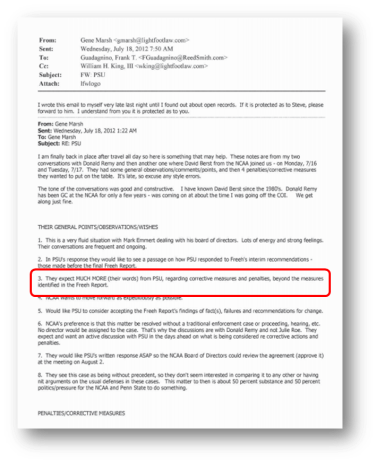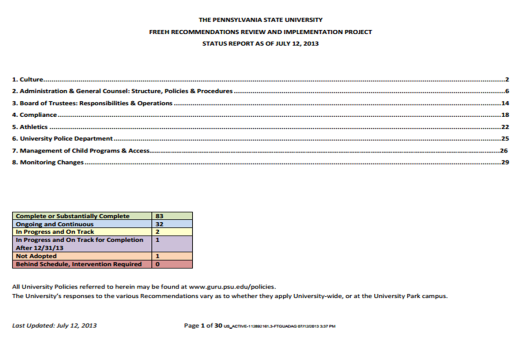On September 8th, 2014 the NCAA announced that it would reduce all of the remaining sanctions against Penn State that directly affected playing football on the field. This included restoration of a full complement of scholarships and declaring Penn State eligible for post-season play in 2014. This comes on the heels of a frist round of “reductions” in sanctions after the first full year they were in effect. In announcing this reduction the NCAA stated:
“Due to Penn State University’s significant progress toward ensuring its athletics department functions with integrity, the NCAA Executive Committee today eliminated the school’s postseason ban, effective immediately”
The NCAA was of course referring to the “Athletics Integrity Agreement” and the just published report by George Mitchell, the Athletics Integrity Monitor at PSU. That report was described as “glowing” by the folks over at Penn Live. Over the 2 years since the sanctions were announced, they were reduced with each release of the annual report by Mitchell. This led some to be able to claim that Penn State was doing substantial work in “fixing” their broken “football culture” (though those who follow this story know the real reason is that the media narrative is falling apart rapidly as lawsuits proceed into discovery phases). In fact Mitchell himself spoke in similar terms:
“In light of Penn State’s responsiveness to its obligations and the many improvements it has instituted, I believe these student-athletes should have the opportunity to play in the postseason should they earn it on the field this year.”
Mitchell was referring to Penn State’s “responsiveness” in implementing the recommendations contained in Chapter 10 of the Freeh Report. As part of the Consent Decree the Penn State Board of Trustees agreed to implement the recommendations of Chapter 10 of the report. In fact this is as close to “accepting” the Freeh report the as the Board has ever come, only admitting to “accepting it for the purposes of the consent decree”.
The last comprehensive list that the university published on the progress of the recommendations is dated July 12, 2013 and can be found here. You can see at the time that not all recommendations have been implemented.
One recommendation, 2.2.1, was dropped with the consent of the NCAA and the Big Ten Conference as noted in the matrix. However you can see that at least 1 other, 2.2.7 HR Information System, was considered not complete and would not be by the agreed upon acceptance date of 12/31/2013. Since that time this matrix has not been published in this form, but rather the University decided to do something sneaky. In August of 2014 the University published a document they called “Phase II – The Plan for Continuous Improvement”. This document looks similar to the previous Freeh recommendation update document but it is not the same. It states:
“The attached matrix identifies ongoing projects — some of which relate to ongoing work on recommendations contained in the Freeh Report and some of which are new or separate from those recommendations – to be used as a tracking tool and a status report.”
The specific recommendation numbers are no longer evident and the University moved to alpha numeric coding for these items which makes it more difficult to tie them specifically back to any particular Freeh recommendation. In addition the report notes itself that this is only partly covering Freeh. You will find similar language in Senator Mitchell’s September report as well.
On top of that funny business, and as a fellow Penn State blogger first noted here, The Board also is not current on it’s promise to fulfill recommendation 3.7 which states “Continue to conduct and publicize periodic internal and external self‐ assessments of Board performance.” As his story notes, the board failed to complete self assessments beginning in 2012 and it’s next assessment was scheduled for January 2014. In my searches I have not been able to find any other Board self-assesments. Further if you thought perhaps this was covered in Mitchell’s recent report, you would be disappointed as it is not.
However, recent filings in the ongoing lawsuits show that even total compliance with these 119 recommendations (which as I just demonstrated the board has not met) would actually not be sufficient to fix the supposed “football culture” at PSU. In an email just days before the sanctions were announced Gene Marsh, who was obtained by PSU to help deal with the NCAA, wrote an email which summarized his notes from a meeting he had with the NCAA’s Donald Remy (Legal Counsel) and David Berst (Vice President of Div I). This is Exhibit 38 of the December 1, 2014 filing in Corman v. NCAA/PSU.
You can see that point 3 was the idea that Penn State would have to go above and beyond the Freeh recommendations, or do “MUCH MORE” in Remy and Berst’s own words, to satisfy the NCAA that Penn State had fixed it’s culture problem. In a moment of symbolism, in light of the criticism of Joe Paterno, the NCAA was demanding that Penn State had to go beyond the ‘legal’ minimum, if you will, and fulfill a ‘moral obligation’ to go the extra mile. Yet to date the Board has not even met their ‘legal’ minimum according to the contract it signed, the consent decree, let alone “MUCH MORE” in the words of Remy and Berst. So how on earth did Penn State get it’s sanctions reduced? It certainly isn’t for ‘good behavior’ as I have just demonstrated. Is it because that was part of the plan all along? Just like Penn State begged the NCAA to “frame” it in the Board’s favor, was this another part of a negotiated end game to sweep everything under the rug and ‘move forward’?
What is pretty clear is that good behavior has nothing to do with this accelerated reduction in sanctions. The Board so far has instituted a policy that allows one-on-one supervision of children (AD73, a no-no in most reputable child-care situations), has a laughable conflict of interest policy still in place, has blatantly disregarded input from both the PA legislature and Governor Elect on Board reform by increasing the size of the Board, and has failed to even meet the minimum requirements of the consent decree. What they clearly tried to do was throw Penn State fans and community members a bone with our “eligibility” for a bowl game and restoration of full scholarship complement. This is because they fear discovery, and what that entails. When real transparency happens, what we will all find out is that this has been one big orchestrated mess to try and hide the real monsters at Penn State, those on and connected to the Board who would use our great community as a means to enrich their personal bank accounts.


